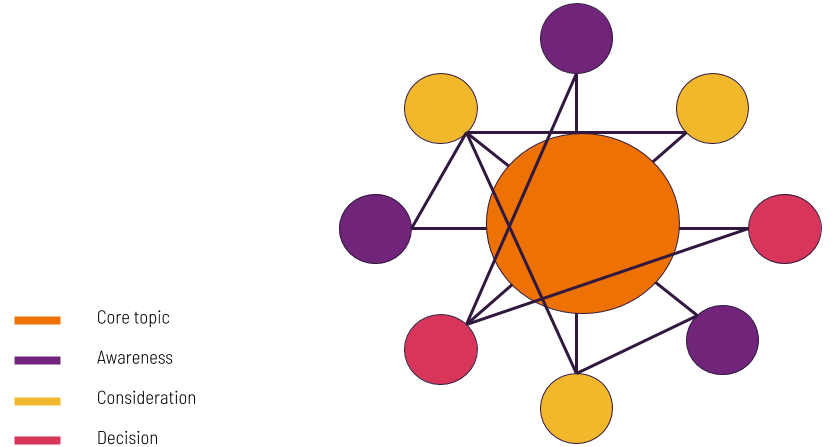Understanding search intent is a key part of any SEO strategy today. It’s not just what your audience searches for, or what keywords they use, but what they expect to find on the other side. As search engines try to provide the best content for their users, they are getting better at identifying what they want to achieve and providing them with the content they need to fulfil their objectives.
Search intent has a deep impact on search results. One of the main goals of Google is to provide the best experience for their users. This mission drives all of their decisions in terms of weighing the different ranking signals. Loading speed, for example, serves as a marker for a good experience for searchers. Meeting the searcher intent is key to provide a good searching experience, so Google tends to arrange the search results to meet the user intent. Search intent also affects what kind of search page results features are triggered.
What is search intent?

Search intent, also called user intent or keyword intent, is the goal the user has when searching for a specific query in a search engine. What they want to achieve with that search.
Table of Contents
ToggleTypes of user search intent
There are three main types of user intent: informational, transactional and navigational. Google prefers the term micro-moments, defined as the action to use a device to fulfil a need, and breaks them down into four types of moments: information, navigation, action and transaction.
Local intent: where is this?

These kinds of search queries almost always include a geographic marker or a location name. This narrows down the search results in Google to a geographical area. There’s also the option to add “near me” to the search query, which will provide search results from the local area.
These types of query show special features in Google like special links at the top and a map with three local listings showcased. Below that, all the search results are related to the geographic location of the user.
Informational intent: what is this?

Informational queries want to understand or expand information and knowledge about entities, concepts, people or events. These queries trigger different search features. In this case, we usually see a knowledge panel with a definition, frequent related questions, images and, in the case of foods, nutritional information. The search results are informational, with no local or transactional links.
Comparative intent: which is best?

Comparative queries include two or more brand or product names, or the modifiers best, worst, least, most, or any similar words. This search intent is usually quite easy to identify, and being just one step above the transaction in a conversion funnel, these search results are usually quite competitive.
Transactional intent: where can I buy this?

Transactional intent means people are using these terms to look for places where to buy something, from smartphones to clothing to food, online and in a nearby location. Depending on the search query, different search features are triggered.
Navigational intent: which website is this?

Brand search terms usually point to a navigational intent. What the users are most likely to achieve is to find a website for a brand or product.
How to discern search intent
Understanding what motivates the user when using a search query is a key stage of a keyword research strategy.
If you want to know more about how to conduct keyword research, this video from Ahrefs explains a step-by-step process to finding out the keywords your target audience are using to find the content, products and services they need.
Once you have determined a list of keywords aligned to your brand, product or services that you wish to rank for, you need to assign a search intent. That way you can create or optimize content that meets that search intent.
The best way to determine the search intent of a given query is to examine the search result pages. Sometimes the intent will be explicit and easy to determine. Usually local and transactional intent are easy to spot. Other times the intent will be mixed, which can often happen in broad queries. Looking at a tool like SEMRush or Ahrefs, you can also spot a mixed intent query when the number of clicks is low compared to the monthly search volume. This means that people aren’t often finding what they are looking for with that query.
A high volatility in search rankings for that keyword is also a signal that search intent is mixed and Google is trying to figure out what people want by modifying frequently the rankings. A user’s past search behavior may, in this case, give Google signals on what would be the most appropriate intent.
To discern what search intent is most favored by Google, you need to go beyond the SERP and the features the keyword triggers in the SERP and look at the ranking content.
In other cases the search query may have several different meanings. Lumen, for example, may be a measurement unit, a nutritional device, a programming framework, an online learning site or a dating app. Ranking for such a keyword will result in a low number of traffic relative to the keyword’s monthly search volume, as most searches will actually be looking for something else.
Search intent can also change and adapt to special circumstances. For example a transactional query can then have an informational intent if there are important news surrounding a product (an example of this could be a product recall).
Determine if your content supports the search intent

To evaluate if your content supports search intent you need to look into your organic search performance. Look at your top-performing keywords and analyze if the content of the landing page matches the search intent of the keyword. Other performance indicators of the landing page, like time spent on page, bounce rate and conversion rate can give you an indication if you’re not meeting the user’s needs with that content.
Your product pages should rank for transactional keywords while your blog pages, articles and other informational content should rank for informational keywords.
Develop a content marketing strategy to support search intent

Having a customer journey map and content mapped to the different stages of the customer journey will help you greatly when developing a content strategy that takes into account search intent.
Using your customer journey map, align keywords to different stages in the customer journey and search intent. In doing that, you’ll have clarity into what kind of content you need to develop and which keywords to target. Aligning content and search marketing this way will allow you to present users with the content they need exactly when they need it,
Supporting content elements in the landing page can help to drive conversions, moving them to the next stage in their customer journey.
Understanding the search intent of your main keywords can simplify and provide clarity to your SEO strategy, as it’ll inform each optimization and tactic. Meeting search intent will boost your SEO success and drive users faster through your customer journey.
Tools like Metigy can help you develop a content marketing strategy to support search intent. Metigy’s new Google Ads module makes it easy to discover what keywords your customers are using when displaying purchase intent.
Learn more about Metigy here.









